Insect Pests of Houseplants
Houseplants have fewer insect pests than outdoor ornamentals do, but they are not pest free. Most houseplant pests are small insects or mites that spend most of their time on the undersides of the leaves. These include aphids, whiteflies, mealybugs, scales, thrips, spider mites, and broad mites. Heavy infestations of any of these pests can cause houseplants to be unsightly and undesirable. Indoor gardeners should know how to recognize and control these pests.
The insects and mites that occur on houseplants also occur in commercial greenhouses, but commercial producers have access to a much wider array of effective insecticides and biological control agents than homeowners do. Control options for commercial greenhouses are not discussed here. This publication focuses on insect pests of houseplants grown in home settings and discusses control options that are available to homeowners.
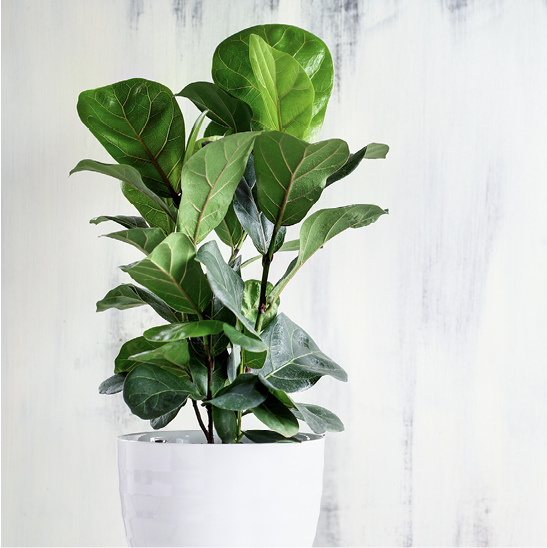
Aphids
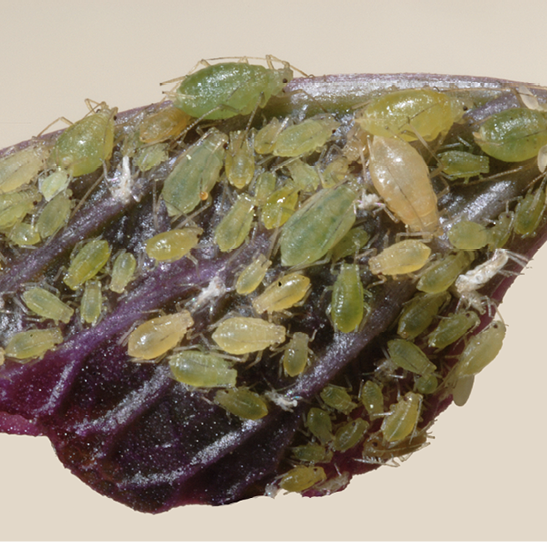
Several aphid species occur on houseplants. Aphids are small, soft-bodied insects. They concentrate on new growth and on the undersides of leaves, where they use their piercing and sucking mouthparts to feed on plant sap. They excrete undigested sugars as honeydew, which accumulates on leaves and tabletops and makes them sticky. Honeydew can also support the growth of sooty mold fungi, resulting in an unsightly black coating on the leaves that is difficult to remove.
Aphids usually reproduce without mating, giving birth to live nymphs that look like smaller versions of the adults. Immature aphids must shed their skins to grow. Their old, shed skins accumulate on the plant, where they are often mistaken for live insects. In addition to honeydew and sooty mold, heavy aphid infestations cause distorted leaves and poor growth.
Aphids are a bit easier to control than most other houseplant pests because all stages—nymphs to adults—respond to control at any given time. Foliar sprays with a ready-to-use product containing imidacloprid and cyfluthrin or acetimiprid will usually give fast, effective control. The recommended insecticide table lists several other effective foliar sprays, but good spray coverage is more critical with other sprays. Imidacloprid will also control aphids when applied as a drench treatment to the soil or potting mix. Simply washing the aphids from the plant with a forceful spray of water can control aphids in some situations. The spray should be just strong enough to wash the aphids off the leaves, but not so strong that it damages the plant.
Whiteflies
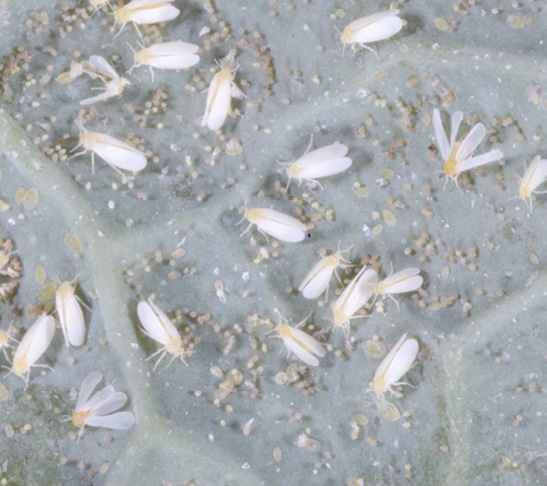
Greenhouse whitefly and silverleaf whitefly are the two most common species of whitefly found on houseplants. Adults of both species look much alike. They have white, powdery wings that they hold tent-like over their bodies when at rest. When the leaves are disturbed, whiteflies will fly around the plant.
Although adult whiteflies are relatively easy to detect, many gardeners have difficulty finding and recognizing the immatures. Whitefly nymphs have flat, oval bodies and are immobile. They feed on the undersides of leaves with their sucking mouthparts embedded in the leaf tissue. The last nymphal instar is a nonfeeding, transformation stage that is sometimes referred to as a “pupa.” Adults emerge through a T-shaped slit in the back of the pupal case.
After mating, female whiteflies attach their tiny white eggs to the undersides of leaves, often in a semi-circular pattern, and the newly hatched crawlers do not move very far before beginning to feed and molting to the immobile stage. Whiteflies damage plants by causing honeydew and sooty mold and by reducing plant growth. They also spread many important plant virus diseases.
Whiteflies are difficult to control, and you will not succeed by treating only the adults. You have to control the immatures on the undersides of the leaves to eliminate a whitefly infestation! Soil treatments with the systemic insecticide imidacloprid, foliar sprays with horticultural oil, or both are the most effective treatments for whiteflies. Foliar sprays with acetamiprid are also effective. Azadirachtin is an effective organic treatment that works by disrupting the growth of the immatures. Azadirachtin requires several successive treatments to obtain control, and you must get excellent coverage of the undersides of the leaves with each treatment.
Mealybugs
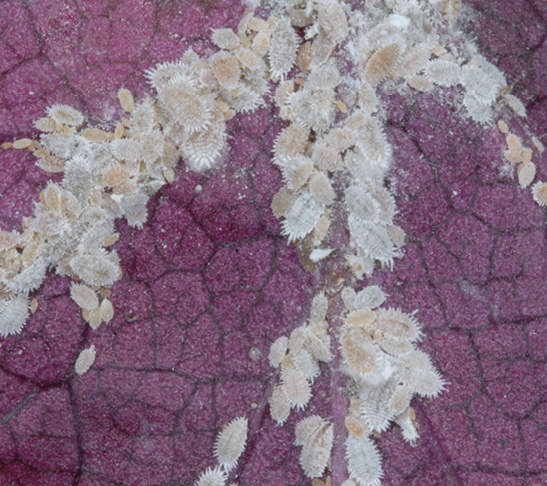
This is one of the more difficult houseplant pests to control. Mealybugs get their name from the white powdery material that covers their bodies. There are several species that attack houseplants, but all are similar in appearance and habits. A mature female is oval and wingless. She has short projections along the margins of her body and is covered with a white, powdery material. Nymphs look similar but smaller. Nymphs may be pale yellow to white. Females lay their eggs in egg sacs that are covered in a cottony material. Newly hatched nymphs do not crawl far before inserting their sucking mouthparts into the plant, but older nymphs do move about on the plants. Infestations are usually concentrated on the undersides of leaves and on new growth in the terminal of the plant. Heavily infested plants will be covered with honeydew and sooty mold, and leaves and terminals may be crinkled and distorted.
If you are thorough and persistent, you can eliminate mealybugs from a small plant by hand-picking, but you will have to use insecticides to control larger infestations. Foliar sprays with acetamiprid are one of the more effective treatments for mealybugs, but plan on that taking multiple treatments. Foliar sprays of horticultural oil will control mealybugs if you do a good job with spray coverage, but you may need to spray several times. Some plants can be injured by oil sprays. Read the label carefully before treating. Soil treatments with imidacloprid are slow-acting but usually provide good long-term control. If you have a heavy infestation, use both an oil spray and an imidacloprid soil treatment. Be sure to isolate infested plants until you get the problem solved.
Scale Insects
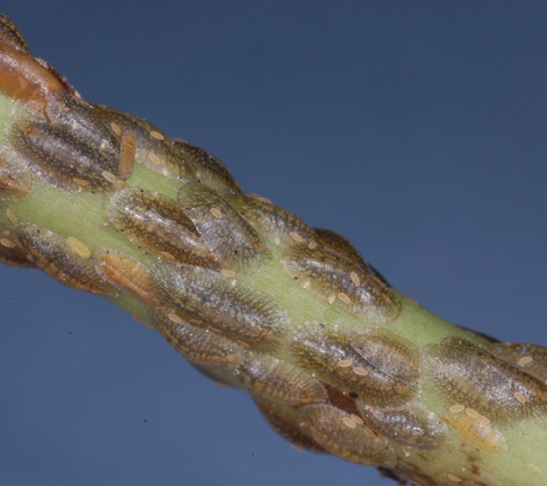
When dealing with scale insects, it is important to distinguish between soft scales and armored scales. But there are many species within each of those two groups. One of the main differences is that soft scales produce honeydew, while armored scales do not. Most of the scales that commonly occur on houseplants are soft scales.
Brown soft scale is the most common scale of houseplants; it occurs on ferns, schefflera, ficus, orchids, and many other indoor ornamentals. Sticky leaves are usually the first sign of a soft scale infestation. Carefully examine the undersides of leaves to check for the flat, oval-shaped scale. Mature females are about three-sixteenths of an inch long and brown. They reproduce without mating. They look like brown bumps on the undersides of the leaves. Both immatures and adults are usually concentrated along leaf veins. Females lay eggs or give birth to live crawlers that usually do not move far before beginning to feed. Once crawlers molt, they remain immobile for the remainder of their lives, using their long, thread-like mouthparts to probe the plant and suck sap.
Hemispherical scale is another soft scale that often infests indoor plants. Although scale insects do not fly, crawlers can be carried to uninfested plants by hitching a ride on people, birds, or flying insects. In indoor settings, uninfested plants become infested when their leaves touch those of an infested plant or when someone handles an infested plant, gets some crawlers on their shirtsleeve, and then handles an uninfested plant.
Scale infestations are notoriously difficult to eliminate, so avoid buying or acquiring infested plants if possible. If you do have infested plants, you must first decide whether you would rather treat the plant aggressively or discard it instead. Systemic soil treatments containing imidacloprid will usually do a good job controlling brown soft scales and other soft scales. Imidacloprid is less effective on armored scales. Foliar sprays with horticultural oil usually work better against armored scales and are also useful against soft scales. Be sure to follow label directions when using oil sprays, and plan to make several treatments.
Thrips
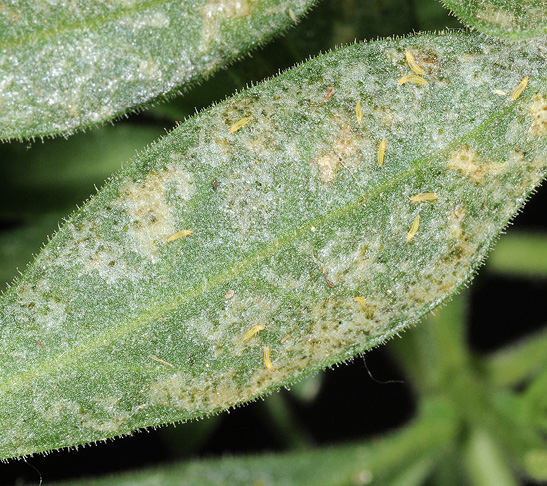
Several species of thrips occur on houseplants. All are tiny insects (one-eighth of an inch long or less) with elongate, spindle-shaped bodies. Adults and larvae feed in the same way. The insect ruptures plant tissue with its single, sharp mandible and sucks up the sap. Most of the species that occur on houseplants feed on the undersides of leaves and on tender new growth, resulting in distorted growth and leaves that curl downward. One species causes unsightly leaf galls on weeping fig, Ficus benjamina. Fortunately, this thrips does not infest many other plants. Some species feed on flower blooms, especially as adults, but the immatures of flower-feeding thrips usually feed on the undersides of leaves.
Foliar sprays with products containing spinosad or acetamiprid are the most effective treatments for thrips, but plan on making two or three sprays at seven-day intervals. Take plants outside before treating. A foliar spray with a ready-to-use product containing imidacloprid and cyfluthrin will also work, but may be less effective than spinosad or acetamiprid. Apply a second treatment in 7 to 10 days, even if you think you have gotten good control. Insecticidal soap, horticultural oil, and azadirachtin will also work if you get good spray coverage. Soil treatments with imidacloprid will provide long-term suppression. The species that causes galls on weeping figs is especially difficult to control. Inspect weeping figs carefully before purchase, and don’t buy plants that have any leaf galls.
Spider Mites
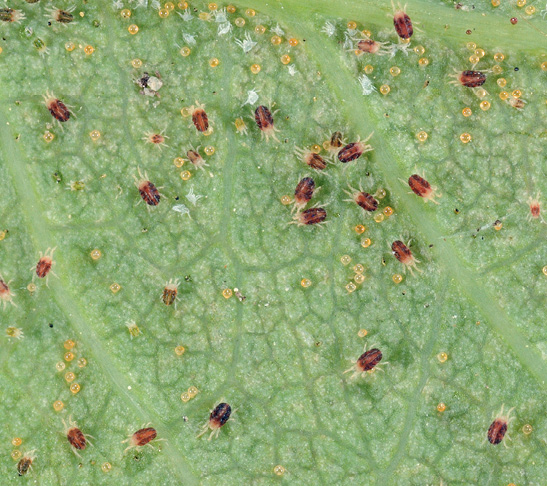
There are several species of spider mite, but the twospotted spider mite is the most common. Spider mites feed on the undersides of leaves, using their tiny, sucking mouthparts to probe individual leaf cells. This results in tiny spots of dead tissue that often give a stippled look to the upper side of the leaf. More severely damaged leaves may be yellowed, bronzed, or brown and crinkled, and heavy infestations of spider mites are capable of killing plants. Heavy infestations produce fine webbing over the leaves and terminals, which makes plants appear to be covered with spider webs. Plants growing in especially warm locations (as in under the heating vent) and plants that are not being adequately watered are especially susceptible to spider mites.
Foliar sprays of horticultural oil, neem oil, or insecticidal soap are some of the most effective treatments available to homeowners to control spider mites. It is important to get thorough coverage of the undersides of leaves and to treat two to three times at 5-day intervals. Be sure to check the label of horticultural oils before applying at close intervals. Washing the mites from the leaves with a forceful spray of water is sometimes practical and effective on small plants, especially if you repeat this washing several times at 3- to 5-day intervals. Misting leaves of infested plants with water daily can also help discourage spider mites, but this treatment can also encourage foliage diseases. Systemic imidacloprid treatments do not control spider mites.
Broad Mites and Cyclamen Mites
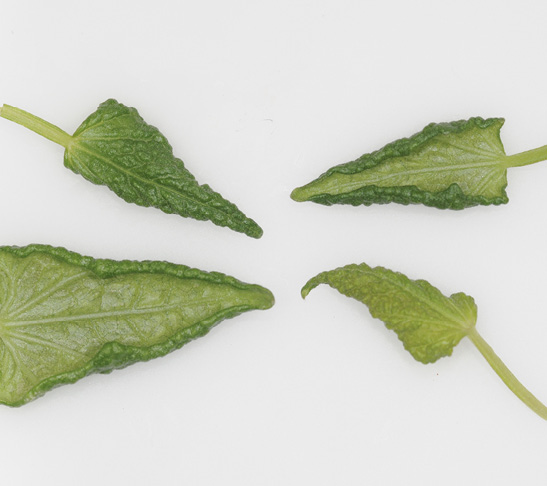
These mites are considerably smaller than spider mites and are usually identified by their damage and what species of plant they are infesting, not the mites themselves. Damage is often mistaken for some other malady, such as herbicide injury, virus infection, or nutritional problem. Cyclamen mite is the most damaging pest of African violets, causing leaves to be puckered and distorted. Broad mites are most often found on begonias, gerberas, impatiens, and a few other plants. Infested leaves may be bronzed or distorted, crinkled, or thickened. They may be brittle or easily broken when handled. Despite their small size, these mites can quickly spread to uninfested plants by hitching rides on shirt sleeves or on flying insect pests, even pests as small as whiteflies.
Discarding infested plants is probably the best way for most homeowners to deal with broad mite and cyclamen mite infestations. Some gardeners try to salvage infested plants by totally immersing the plants, pot and all, in hot water (110 to 120 degrees) for 15 minutes. The goal is to cook the mites without killing the plants. Do your homework before trying this method, as temperatures and treatment times vary depending on plant species. You can try to control these mites with repeated applications of insecticidal soap. The spray will kill all the mites it contacts. But if you miss even a few mites, the infestation will return.
Fungus Gnats
Most homeowners first notice the tiny, gnat-like adult flies of the fungus gnat, but the larvae are actually more damaging to the plants. The slender, white larvae live in the potting media or soil. They feed on decaying organic matter and developing root hairs. Excessive root pruning due to heavy infestations can adversely affect plant growth. Most homeowners are more bothered by the tiny adults. Although these tiny, gnat-like flies do not bite, they can be a minor nuisance, especially when numerous. Fungus gnat larvae thrive in growing media that is kept excessively moist. Mature larvae are only about a half-inch long with white bodies and shiny black heads.
The key to controlling fungus gnats is to control the larvae developing in the potting soil. Proper watering is an important cultural control practice for this pest because overwatering is favorable to larval development. Allow soil to dry properly between watering, and you will have a lot fewer problems with fungus gnats! A potting soil drench containing the active ingredient Bacillus thuringiensis israelensis is the most effective treatment for fungus gnats (Gnatrol and Knocks-Out Gnats are two of the most readily available brand names). Do not try to control fungus gnats with Bacillus thuringiensis products that are labeled for caterpillar control; they will not work on fly larvae. Likewise, B.t. israelensis will not control caterpillar pests.
Occasional Invaders
Pests that are accidentally brought indoors when outdoor potted plants are moved indoors are called “occasional invaders.” They include pests such as slugs, pillbugs, millipedes, spiders, cockroaches, ants, and other pests. In most cases these pests do not damage the plant, but merely use the plant or the pot or potting media for harborage. However, these pests can be annoying indoors. Before moving plants indoors, check them for spider webs and remove any dead leaves or other debris that has accumulated on top of the potting soil. Also check for fire ants or other ants that may be nesting in the potting soil. When possible, move plants to another outdoor location and leave them there a day or so before moving them indoors. Move the plants at night. Because many of these occasional invaders are active at night, moving plants after dark while the weather is still warm can help reduce the number of occasional invaders that are brought indoors. The objective is to move the plants while occasional invaders like slugs and cockroaches are out looking for food. Waiting until after dark to move plants will not help much if temperatures are so low that pests have become inactive.
Fire Ants
Occasionally fire ants will nest in the potting soil of outdoor potted plants, especially when pots are placed directly on the ground, and this is definitely a situation you want to detect and treat before moving the plant indoors. Reduce the potential for fire ants to invade potted plants by maintaining good control of fire ants in and around the area where potted plants are kept. See Extension Publication 2429 Control Fire Ants in Your Yard for details on preventive fire ant control. To eliminate an established fire ant nest from a potted plant, drench the potting soil with an appropriately labeled product containing the active ingredient permethrin. There are many brand-name permethrin products available to homeowners that provide directions for use as a drench treatment for fire ant mounds. Permethrin provides fast-acting contact control of fire ants. Mix and apply the drench according to label directions while the plant is outside. Wait several days before moving the plant indoors.
Methods of Controlling Insect Pests in Houseplants
Following is a brief review of some of the general methods of controlling insects and mites on houseplants. In most cases, you will need to use a combination of two or more of these methods to achieve and maintain control of a particular pest. For example, to deal with an infestation of mealybugs, you might remove as many insects and egg sacs as possible by hand, spray with a horticultural oil, and apply imidacloprid spikes in the pot.
Hand-Picking
Hand-picking can be an effective way to control or eliminate infestations of certain kinds of pests on small houseplants. This method is most effective against larger, immobile pests like mealybugs and some types of scale. Use tweezers or a cotton swab dipped in alcohol to remove large soft scales or mealybugs and their cottony egg sacs. Check the plant regularly until you are sure you have gotten all the pests. Keep infested plants isolated from other plants.
Pruning
In some cases, plants can be pruned to remove heavily infested limbs and damaged, unsightly leaves. Pruning makes it easier to achieve good spray coverage and may help plants recover more quickly by stimulating new growth. For example, severe pruning is often used on certain ferns infested with soft scales before horticultural oil treatments or systemic media treatments. Use your knowledge as a gardener to decide what type of pruning is appropriate for the particular plant species you are trying to treat.
Water Sprays
Taking plants outside or placing them in the bathtub or kitchen sink and washing the leaves with a forceful spray of water can be an effective way to remove aphids and spider mites. Misting plants daily with water can help reduce spider mite populations. Although such misting can also encourage foliage diseases, it is often worth trying on plants suffering from building mite infestations or plants growing in hot, dry locations.
Cultural Controls
Avoid buying trouble. Check plants carefully for insect and mite infestations before purchasing them. Avoid spreading trouble. Isolate infested plants from other plants until you get the problem solved. Avoid nursing trouble. In some cases, such as an infestations of cyclamen mites on African violets or heavy infestations of scale insects or mealybugs, the best plan may be to discard infested plants to prevent spread to uninfested plants. Avoid overwatering. Overwatering is the main reason for heavy fungus gnat infestations.
Biological Control
Purchasing and releasing specialized parasitic and predatory insects and mites is one of the primary means of insect and mite control used in large commercial greenhouses today. Unfortunately, this type of biological control is not practical in most home settings. This is due to cost and logistical constraints, as well as the level of knowledge and attention it takes to successfully use such biological control agents. The biological control agents most readily available to homeowners, things like praying mantids and large lady beetles, are not very effective against the pests that really need to be controlled. Hobbyists with large greenhouses may be able to use biological control successfully, but such gardeners must use great care and know which agents to use against which pests and how to acquire and use these agents.
Sticky Traps
Yellow sticky traps will attract and catch adult whiteflies, thrips, and fungus gnats. Although sticky traps are useful as survey tools to help detect pest infestations, they do not control insect pests. This is because they do not trap the immatures and catch only a portion of the adults.
Insecticide Sprays
Foliar insecticide sprays can be used to control most insect and mite pests of houseplants. Because most of these products must contact the target pest directly in order to provide control, successful control depends on thorough spray coverage. It is especially important to achieve good spray coverage of the undersides of leaves because this is where most of the pests live, especially the immature stages. Most of the insecticides used on houseplants are available as ready-to-use sprays, which is a convenient way to treat small numbers of plants. If you have large numbers of plants, you may want to purchase insecticides as concentrates and mix your own spray. Always follow label directions. Be aware of potential problems caused by off-target overspray! When possible, move plants outside before spraying, or place plants on unfolded newspapers to catch any overspray. If you do move plants outside to spray, be aware that most houseplants are adapted to low light conditions. They are easily sunburned, so take appropriate precautions to keep your plants from getting sunburned.
Potting Soil Treatments
The systemic insecticide imidacloprid is available in either a granular formulation or a spike for application to potting soil. After being absorbed by the roots, imidacloprid moves into the leaves to provide long-term control of aphids, whiteflies, mealybugs, and soft scales. Products containing Bacillus thuringiensis israelensis can be applied as potting soil drenches to control fungus gnats. Note that Bt products are not systemic and will not control insects feeding on the upper portion of the plant.
Insecticides for Houseplants
The following table lists the active ingredients of the most common insecticides labeled for use on houseplants and provides an example of one brand name product that contains this active ingredient. In many cases there are several other products that contain the indicated active ingredient and are labeled for use on houseplants, and these may work just as well. When you shop for insecticides, look for a product that is labeled for use on houseplants and contains an active ingredient known to be effective against the target pest(s). Do not be confused by brand names or pictures on the product label. For example, a product that mentions spider mites in the product name or has a picture of spider mites on the label is not necessarily the most effective product for spider mites. Products that are difficult to find at local stores can usually be purchased online or by mail from specialty gardening supply stores. Organic gardeners should note that many of the listed products are approved for organic production. Names of organic active ingredients are noted in the table.
|
Active Ingredient(s) |
Brand Name (Example)1 |
% AI and Formulation1 |
Pests Controlled |
|
acetamiprid |
Ortho Flower Fruit and Vegetable Insect Killer RTU |
0.006% ready-to-use |
aphids, thrips, whiteflies2, mealybugs2, scales2 |
|
spinosad3 |
Capitain Jack’s Dead Bug Brew Ready-to-Use |
0.001% |
thrips2, catepillar pests2 |
|
paraffinic oil3 |
Bonide All Seasons Horticultural Spray Oil RTU |
2% ready-to-use |
aphids2, thrips2, whiteflies2, mealybugs2, mites2, scales2 |
|
neem oil3 |
Monterey 70% Neem Oil |
70% liquid concentrate |
aphids, thrips, whiteflies, mealybugs, mites, scale crawlers |
|
azadirachtin3 |
Azatrol, PBI Gordon |
1.2% liquid concentrate |
whiteflies2, mealybugs2, scale crawlers |
|
azadirachtin2 |
Safer BioNeem |
0.09% |
whiteflies2, mealybugs2, scale crawlers |
|
pyrethrins + PBO |
Garden Safe Houseplant and Garden Insect Killer |
0.02% + 0.2% ready-to-use |
aphids, thrips, whiteflies, mites (short residual and limited efficacy) |
|
cyfluthrin + imidacloprid |
BioAdvanced Rose & Flower Insect Killer |
0.003% + 0.012% ready-to-use spray |
aphids2, thrips2, whiteflies, mealybugs, scale crawlers2 |
|
imidacloprid |
Bonide Systemic Insect Control Granules |
0.22% granule (applied to potting soil) |
aphids, thrips, whiteflies, mealybugs, soft scales |
|
imidacloprid |
Bayer 2-in-1 Plant Spikes |
2.5% spike (applied to potting soil) |
aphids, thrips, whiteflies2, mealybugs2, soft scales2 |
|
B.t. israelensis3 |
Knock-Out Gnats by Gardens Alive |
water-dispersible granules |
fungus gnats2 (applied as a potting soil drench) |
|
permethrin |
Hi-Yield Lawn, Garden, Pet, & Livestock Insect Control |
10% liquid concentrate |
fire ants nesting in potting media |
|
insecticidal soap + neem oil + pyrethrin3 |
Safer End All Insect Killer |
1% + 0.9% + 0.12% ready-to-use |
aphids, thrips, whiteflies, mealybugs, scale crawlers, spider mites |
|
potassium salts of fatty acids |
Garden Safe Insecticidal Soap |
1% ready-to-use |
aphids2, thrips2, whiteflies, mealybugs, mites2, scale crawlers |
1 In most cases, the listed formulation is a ready-to-use spray; there are also liquid concentrate products.
2 The listed active ingredient is one of the more effective products for control of this pest.
3 These active ingredients are organic insecticides. Products containing only pyrethrins, without PBO or other synergists, are also organic.
Publication 2652 (POD-06-24)
By Blake Layton, PhD, Extension Professor, Biochemistry, Molecular Biology, Entomology, and Plant Pathology.
The Mississippi State University Extension Service is working to ensure all web content is accessible to all users. If you need assistance accessing any of our content, please email the webteam or call 662-325-2262.



